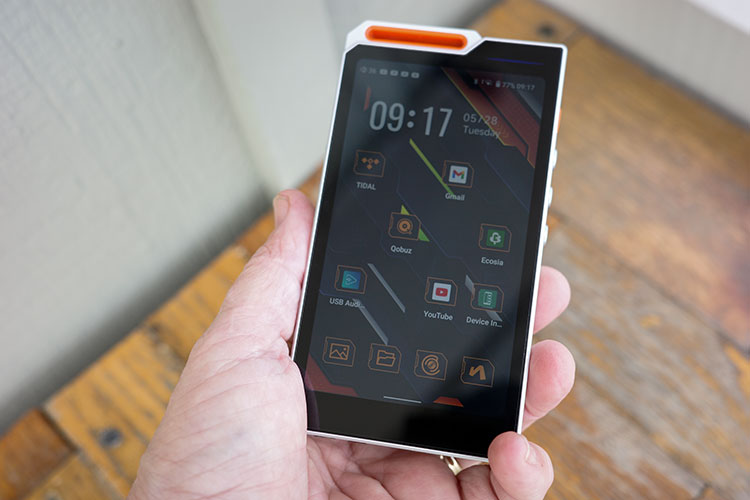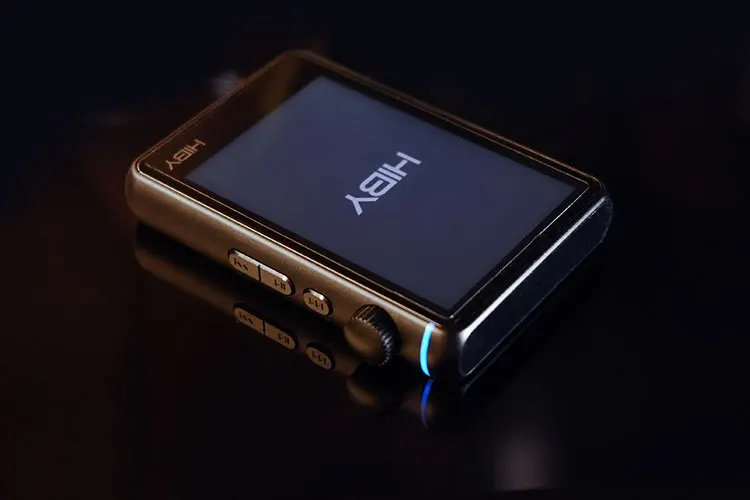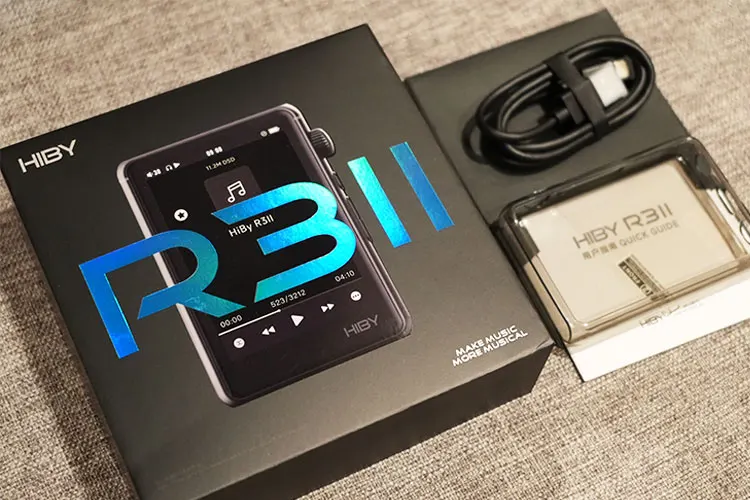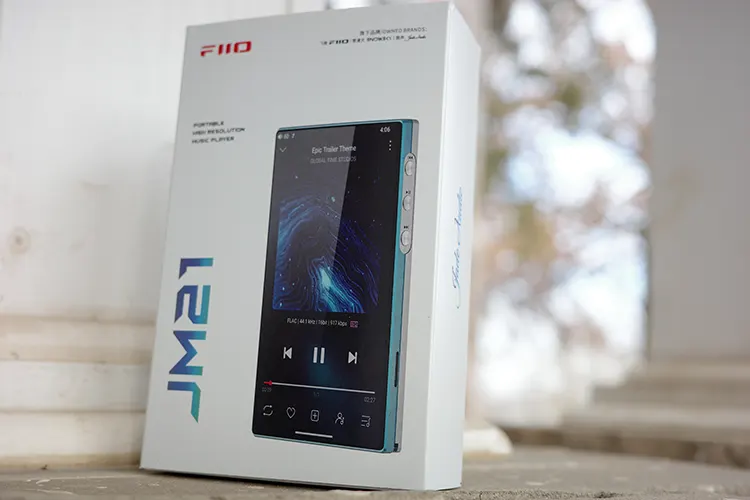Select Comparisons
HiBy R4
Features
The R4 is equipped with Qualcomm’s Snapdragon 665, a lower-tier CPU compared to the 680 inside the JM21. It has 3 GB RAM, and 32 GB ROM, all usable along with open Android. The JM21 uses a more modern custom Android 13, which can still be updated.
Though targeting mainly IEM users, the R4’s 525mW Class-A power at 32Ω (4-OPA1652, 2-OPA1612) out of the 4.4mm balanced jack, is adequate for use with headphones, but cannot match the JM21’s 700mW output.
Both support PCM up to 768kHz/32bit, while the JM21 supports DSD of up to 512. Additional aspects included such as MSEB, PEQ, and the many plug-ins are offered on the R4.
With two-way BT 5.0, the R4 can send and receive Bluetooth, much like the JM21, supporting UDAT, LDAC, aptX, aptX HD, AAC, SBC, and others. It should be noted that aptX and aptX HD only support BT output, while the others listed are two-way.
Design
There is no getting around the different look of the R4. Those edges also allow the user to keep hold of the DAP. I preferred the R4 without the included case in hand, but I preferred the JM21 with the case on, with a good tactile feel to it.
The R4 4.7” touchscreen functions and buttons function without bother. The JM21 feels tactically sound too, with the buttons quickly becoming intuitive. I could quickly access all functions without bother. Two approaches, and both work.
The difference between the R4 and JM21 is felt in hand, and the JM21 feels better overall. The R4 weight of 231g makes it slightly lighter than my iPhone 13 Pro Max but feels much lighter due to the dimensions of 129.6*68.3*18.5mm. The JM21 is lighter in hand and feels that way.
Performance
Where the JM21 comes across as accurate, musical, and detailed, the R4 comes across as neutral. Using “budgetary” equipment to keep the cost reasonable can sometimes mean there are discrepancies that fault the sound.
Not so here. Notes are consistent without any peakiness sometimes associated with the tuning of certain budget-minded parts. The JM21 presents a more musical sound, with better detail retrieval.
The bass of the R4 is clean and not bloated, presenting an engaging signature from the lows to the highs. Sabre DACs tend to be smoother in sound, so this fits the bill. The bass hits slightly harder and lower than the more precise and controlled JM21.
Moving up the scale, there is a slight push in the trebles to the R4, which can come down to the DAC again. The brighter character is portrayed as vibrant and energetic, seemingly antithetical to some budgetary DAP devices, which promote splash where accuracy should be the norm.
Here, the JM21 takes a more neutral approach relying upon the music to color any top-end notes, and does so with very good clarity.
Where the JM21 presents the music accurately and precisely, the R4 gives a slight amount of flavor paired with the more forward midrange.
The sound is engaging and accurate when paired with the FoKus Apollo or FT1 Pro, presenting a bit more “in your face” feel to the music than the accurately presented JM21.
HiBy R3II
Features
The R3 II is equipped with dual ESS SABRE ES9219C DAC chips, which are considered mid-tier and run a warmer signature than the Cirrus Logic-equipped JM21.
It supports decoding up to DSD256 and PCM up to 32BIT/384kHz, with the USB-C interface, while the JM21 provides up to DSD512.
The 4.4mm balanced output delivers a maximum output of 380mW at a 32-ohm load, which is comparable to some mid-range DAPs, but is roughly half of the JM21 700mW balanced output. The JM21 shines here.
Its balanced output provides an output of 3.5 Vrms, while the 3.5mm single-ended output reaches a maximum of 1.9 Vrms and 112 mW on a 32Ω load (also less than the JM21’s 245mW). The dynamic range averages 115dB, bettered by the JM21’s 130 dB.
Design
The R3 II has an aluminum frame, contributing to its lightweight construction, weighing just 118g. This is my traditional mowing/yard work DAP due to its diminutive size.
The indicator bar on the R3 II remains illuminated at all times and changes color to indicate different sampling rates during playback, just like the JM21.
The front features a 3.2″ 320*480 touch panel, which is sufficient for music playback. You can see the direction taken by other DAP manufacturers with larger sizes to their “budgetary” models. Again, the JM21 trumps those numbers by quite a bit.
The back of the device is covered with curved glass. Despite its lightweight design, the R3 II packs a battery inside, which gives a good amount of playtime.
The user interface is designed to optimize the screen size, allowing for easy single-handed scrolling through different screens. The user interface of the JM21 is comparable, especially with the larger screen size helping.
Performance
The R3 II is tuned on the safe side with the upper register nicely rounded and not too sharp sounding. This is similar to the JM21, and I like both approaches.
I would highly recommend using the MSEB tuning panel to achieve better clarity and openness, especially with IEMs that have a richer or more fulsome tuning. The JM21 is less in need of EQ’ing but can be done so, too.
On the 3.5mm output, you will notice the sound is quite a bit softer, and the treble is also more rounded. The JM21 comes across both 3.5 and 4.4 with a better balance, but I did prefer the 4.4 balanced out.
There is a fun factor to the signature though, which puts it slightly ahead of the JM21 in my opinion, when not including detail retrieval. Overall character though, goes the way of the JM21 due to its versatility, larger screen, and more powerful outputs.
My Verdict
The FiiO JM21 promotes itself as a musical DAP first and foremost. Equally at home as a streamer using the USB-C DAC out function allows the connection to external sources for listening, which may not be the case in some competitors. This is a positive to me.
The sound comes across as musical and clear. The typical FiiO crispness to the signature allows the sound to showcase what you hear. Yes, changing listening devices will alter this, but paired with the right IEM or headphones, the JM21 shines in this segment.
There aren’t many that can compete with the FiiO detailed signature, and the JM21 carries this on at an affordable, no-nonsense level. But it does have limitations.
The FiiO music app is adequate, but not nearly as good as HiBy’s Music app. I also have a pause over that lip on the bottom of the case. While it works, the longevity of it might come into question.
These “limitations” should not dissuade you from giving the JM21 a listen. When used singularly for music or streaming, it competes with its peers very well. And that really is the point of the JM21, to pass along unencumbered music for us to enjoy.
FiiO JM21 Technical Specifications
- Color: blue
- Material: Aluminum alloy & plastic
- Dimensions: 120.7x68x13mm
- Weight: About 156g (excluding the transparent case)
- SoC: Qualcomm Snapdragon 680
- RAM & Storage: 3G RAM+32G ROM (22G ROM usable)
- Storage expansion: Standard micro-SD up to 2TB
- Android: 13-custom
- Working mode: Android mode/Pure music mode/USB DAC mode/ Bluetooth receiving mode
- WiFi: 2.4GHz/5GHz; supports DLNA, AirPlay, WiFi music transfer, etc
- DAC: CS43198*2
- Op-amp: SGM8262*2
- Display: 4.7” HD (750×1334 resolution)
- Outputs: single-ended 3.5mm PO/SPDIF + 4.4mm balanced
- USB connector: Type-C USB2.0 data/charging/USB Audio
- Bluetooth version: 5.0
- Bluetooth transmission: SBC/AAC/aptX/aptX HD/LHDC/LDAC
- Bluetooth reception: SBC/AAC/LDAC
- Local decoding: 384kHz/32bit; DSD256 (Native)
- USB DAC: 384kHz/32bit; DSD256 (Native)
- USB Audio: 768kHz/32bit; DSD512 (supports DoP/D2P/Native)
- Coaxial output: 384kHz/32bit; DAD128 (supports DoP/D2P)
- Output power 1: L+R>245mW+245mW (32Ω/THD+N<1%/single-ended)
- Output power 2: L+R>700mW+700mW (32Ω/THD+N<1%/balanced)
- Signal-to-noise ratio: >130dB
- Noise floor: <1.5µV
- Output impedance: <1Ω
- THD+N: <0.0006%
- Battery capacity: 2400mAh
- Battery life: Single-ended 12.5h, balanced 9.5h
- Charging time: About 2h (5V 2A power supply)







